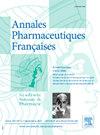PLAROsomes as a modified liposomes delivery system for Mimosa pudica L. extract: Augmenting anticancer potential against prostate and skin cancer cell lines
IF 1.1
Q4 PHARMACOLOGY & PHARMACY
引用次数: 0
Abstract
Objective
PLAROsomes, a modified liposomal drug carrier system, were developed to overcome the major drawback of drug leakage in conventional liposomes. This study aimed to encapsulate Mimosa pudica L. extract (MIPA) within PLAROsomes to enhance anticancer efficacy against prostate (PC-3) and skin (B16F10) cancer cell lines.
Method
PLAROsomes were formulated using the thin-film hydration technique and characterized through infrared (IR) and ultraviolet (UV) spectroscopy, thermal analysis (TGA and DSC), particle size distribution, zeta potential measurement, and morphological assessment via SEM and TEM. Key formulation parameters, including encapsulation efficiency (%EE), drug loading capacity (%DLC), and drug release (%DR), were optimized for stability and efficacy. Cytotoxicity was evaluated using the MTT assay. Additionally, MIPA-loaded PLAROsomes were prepared without 2-methyl-resorcinol to assess its role in preventing drug leakage.
Results
The optimized MIPA-loaded PLAROsomes had a particle size of 193.2 ± 41.6 nm, confirmed by TEM at 139 ± 15 nm. They exhibited higher encapsulation efficiency (83.45 ± 0.45%) and drug loading (9.85%) compared to formulations without 2-methyl-resorcinol (74.56 ± 0.65% EE and 8.80% DLC), indicating its stabilizing effect. Drug release followed the Korsmeyer-Peppas model, demonstrating a sustained profile. At 100 μg/mL, MIPA-loaded PLAROsomes significantly reduced cell viability (52.22 ± 1.54% in B16F10 and 45.57 ± 0.80% in PC-3), outperforming the free extract.
Conclusion
MIPA-loaded PLAROsomes exhibit enhanced anticancer potential and could serve as an effective targeted therapy, warranting further clinical investigation.
Objectif
Les PLAROsomes, un système de transport de médicament liposomal modifié, ont été développés pour surmonter l’inconvénient majeur de la fuite de médicament dans les liposomes conventionnels. Cette étude visait à encapsuler l’extrait de Mimosa pudica L. (MIPA) dans les PLAROsomes pour améliorer l’efficacité anticancéreuse contre les lignées cellulaires cancéreuses de la prostate (PC-3) et de la peau (B16F10).
Méthode
Les PLAROsomes ont été formulés en utilisant la technique d’hydratation en couche mince et caractérisés par spectroscopie infrarouge (IR) et ultraviolette (UV), analyse thermique (TGA et DSC), distribution granulométrique, mesure du potentiel zêta et évaluation morphologique via SEM et TEM. Les principaux paramètres de formulation, notamment l’efficacité d’encapsulation (%EE), la capacité de chargement du médicament (%DLC) et la libération du médicament (%DR), ont été optimisés pour la stabilité et l’efficacité. La cytotoxicité a été évaluée à l’aide du test MTT. De plus, les PLAROsomes chargés de MIPA ont été préparés sans 2-méthyl-résorcinol pour évaluer son rôle dans la prévention des fuites de médicament.
Résultats
Les PLAROsomes optimisés chargés en MIPA avaient une taille de particule de 193,2 ± 41,6 nm, confirmée par TEM à 139 ± 15 nm. Ils ont montré une efficacité d’encapsulation (83,45 ± 0,45 %) et une charge en médicament (9,85 %) supérieures à celles des formulations sans 2-méthyl-résorcinol (74,56 ± 0,65 % EE et 8,80 % DLC), indiquant son effet stabilisateur. La libération du médicament a suivi le modèle de Korsmeyer-Peppas, démontrant un profil soutenu. À 100 μg/mL, les PLAROsomes chargés en MIPA ont réduit de manière significative la viabilité cellulaire (52,22 ± 1,54 % dans B16F10 et 45,57 ± 0,80 % dans PC-3), surpassant l’extrait libre.
Conclusion
Les PLAROsomes chargés de MIPA présentent un potentiel anticancéreux accru et pourraient servir de thérapie ciblée efficace, justifiant des recherches cliniques plus approfondies.
PLAROsomes作为改良的含羞草提取物脂质体递送系统:增强对前列腺和皮肤癌细胞系的抗癌潜力。
目的:为克服常规脂质体药物漏药的缺点,研制了一种改良的脂质体药物载体体系PLAROsomes。本研究旨在将含羞草提取物(Mimosa pudica L. extract, MIPA)包埋在PLAROsomes内,以提高其对前列腺(PC-3)和皮肤(B16F10)癌细胞的抗癌作用。方法:采用薄膜水化技术制备PLAROsomes,并通过红外(IR)和紫外(UV)光谱、热分析(TGA和DSC)、粒度分布、zeta电位测量以及SEM和TEM形态学分析对其进行表征。对包封率(%EE)、载药量(%DLC)、释药量(%DR)等关键处方参数进行了稳定性和有效性优化。采用MTT法评价细胞毒性。此外,制备了不含2-甲基间苯二酚的mipa负载PLAROsomes,以评估其在防止药物泄漏中的作用。结果:优化后的负载mipa的PLAROsomes的粒径为193.2±41.6nm, TEM在139±15nm处证实。与不含2-甲基间苯二酚的制剂(EE为74.56±0.65%,DLC为8.80%)相比,其包封效率(83.45±0.45%)和载药量(9.85%)更高,表明其具有稳定作用。药物释放遵循Korsmeyer-Peppas模型,显示出持续的特征。在100μg/mL浓度下,负载mipa的PLAROsomes显著降低细胞活力(B16F10为52.22±1.54%,PC-3为45.57±0.80%),优于游离提取物。结论:负载mipa的plarosome具有增强的抗癌潜力,可作为有效的靶向治疗,值得进一步的临床研究。
本文章由计算机程序翻译,如有差异,请以英文原文为准。
求助全文
约1分钟内获得全文
求助全文
来源期刊

Annales pharmaceutiques francaises
PHARMACOLOGY & PHARMACY-
CiteScore
1.70
自引率
7.70%
发文量
98
期刊介绍:
This journal proposes a scientific information validated and indexed to be informed about the last research works in all the domains interesting the pharmacy. The original works, general reviews, the focusing, the brief notes, subjected by the best academics and the professionals, propose a synthetic approach of the last progress accomplished in the concerned sectors. The thematic Sessions and the – life of the Academy – resume the communications which, presented in front of the national Academy of pharmacy, are in the heart of the current events.
 求助内容:
求助内容: 应助结果提醒方式:
应助结果提醒方式:


